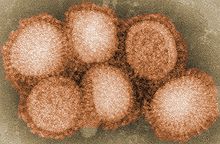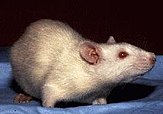User:Caron.m/sandbox
In biology, a strain is a low-level taxonomic rank applied to a "pure" population of organisms, usually within a species. Strains are often seen as inherently artificial concepts, characterized by a specific intent for genetic isolation.[1] This is most easily observed in microbiology where strains are derived from a single cell colony and are typically quarantined by the physical constraints of a Petri dish. Strains are also commonly cataloged in virology, botany, and rodents used in experimental studies. Strains may occasionally change over time as a result of genetic aberrations.[1]
Microbiology and Virology
[edit]
A strain is a genetic variant or subtype of a microorganism (e.g., virus or bacterium or fungus). For example, a "flu strain" is a certain biological form of the influenza or "flu" virus. These flu strains are characterized by their differing isoforms of surface proteins. New viral strains can be created due to mutation or swapping of genetic components when two or more viruses infect the same cell in nature[2]. These phenomena are known respectively as antigenic drift and antigenic shift. Microbial strains can also be differentiated by their genetic makeup using metagenomic methods to maximize resolution within species[3]. This has become a valuable tool to analyze the microbiome.
Strain Engineering
[edit]Scientists have engineered flu virus strains pandemic in humans in order to study their behavior. Funding for this research has been controversial as a result of safety concerns, and has been halted at times[4]. However, this research continues today.
In biotechnology, microbial strains have been engineered to establish metabolic pathways suitable for treating a variety of applications[5]. Historically, a major effort of metabolic research has been devoted to the field of biofuel production[6]. Optimized strains of E. coli are typically are used for this application. E. coli are also often used as a chassis for the expression of simple proteins. These strains, such as BL21, are engineered to minimize protease activity, hence enabling potential for high efficiency industrial scale protein expression. In the case of complex proteins including biologics, eukaryotic cells are typically used for expression (CHO cells)
Yeasts are the most common subjects of eukaryotic strain engineering, especially with respect to industrial fermentation[7].
E. coli is most common species for prokaryotic strain engineering. Scientists have succeeded in establishing viable minimal genomes from which new strains can be developed.[8] These minimal strains provide a near guarantee that experiments on genes outside the minimal framework will not be effected by non-essential pathways.
Plants
[edit]The term has no official ranking status in botany; the term refers to the collective descendants produced from a common ancestor that share a uniform morphological or physiological character.[9] A strain is a designated group of offspring that are either descended from a modified plant (produced by conventional breeding or by biotechnological means), or which result from genetic mutation.
As an example, some rice strains are made by inserting new genetic material into a rice plant,[10] all the descendants of the genetically modified rice plant are a strain with unique genetic information that is passed on to later generations; the strain designation, which is normally a number or a formal name, covers all the plants that descend from the originally modified plant. The rice plants in the strain can be bred to other rice strains or cultivars, and if desirable plants are produced, these are further bred to stabilize the desirable traits; the stabilized plants that can be propagated and "come true" (remain identical to the parent plant) are given a cultivar name and released into production to be used by farmers.
Rodents
[edit]
A mouse or a rat strain is a group of animals that is genetically uniform. Strains are used in laboratory experiments. Mouse strains can be inbred, mutated or genetically engineered, while rat strains are usually inbred. A given inbred rodent population is considered genetically identical after 20 generations of sib-mating. Many rodent strains have been developed for a variety of disease models and are often used to test drug toxicity[11][12][13].
See also
[edit]References
[edit]- ^ a b DIJKSHOORN, L.; URSING, B.M.; URSING, J.B. (2000). "Strain, clone and species: comments on three basic concepts of bacteriology". Journal of Medical Microbiology. 49 (5): 397–401. doi:10.1099/0022-1317-49-5-397. PMID 10798550.
- ^ Yong, Ed. "Scientists create hybrid flu that can go airborne". Nature. doi:10.1038/nature.2013.12925.
- ^ Marx, Vivien (2016-04-28). "Microbiology: the road to strain-level identification". Nature Methods. 13 (5): 401–404. doi:10.1038/nmeth.3837.
- ^ Butler, Declan. "Scientists call for 60-day suspension of mutant flu research". Nature. doi:10.1038/nature.2012.9873.
- ^ Lee, Sang Yup (2012-11-16). "Metabolic Engineering and Synthetic Biology in Strain Development". ACS Synthetic Biology. 1 (11): 491–492. doi:10.1021/sb300109d.
- ^ Liu, Tiangang; Khosla, Chaitan (2010-11-03). "Genetic Engineering of Escherichia coli for Biofuel Production". Annual Review of Genetics. 44 (1): 53–69. doi:10.1146/annurev-genet-102209-163440. ISSN 0066-4197.
- ^ Steensels, Jan; Snoek, Tim; Meersman, Esther; Nicolino, Martina Picca; Voordeckers, Karin; Verstrepen, Kevin J. (2014-09-01). "Improving industrial yeast strains: exploiting natural and artificial diversity". FEMS Microbiology Reviews. 38 (5): 947–995. doi:10.1111/1574-6976.12073. ISSN 0168-6445.
- ^ Sung, Bong Hyun; Choe, Donghui; Kim, Sun Chang; Cho, Byung-Kwan (2016-11-30). "Construction of a minimal genome as a chassis for synthetic biology". Essays in Biochemistry. 60 (4): 337–346. doi:10.1042/ebc20160024. ISSN 0071-1365. PMID 27903821.
- ^ Usher, George (1996), The Wordsworth Dictionary of Botany, Ware, Hertfordshire: Wordsworth Reference, p. 361, ISBN 1-85326-374-5
- ^ Maugh II, Thomas H. (18 February 2008). "Geneticist shaped hybrid rice strains - Los Angeles Times". Los Angeles Times.
- ^ Anderson, Mark S.; Bluestone, Jeffrey A. (2004-11-29). "THE NOD MOUSE: A Model of Immune Dysregulation". Annual Review of Immunology. 23 (1): 447–485. doi:10.1146/annurev.immunol.23.021704.115643. ISSN 0732-0582.
- ^ Cheon, Dong-Joo; Orsulic, Sandra (2011-01-24). "Mouse Models of Cancer". Annual Review of Pathology: Mechanisms of Disease. 6 (1): 95–119. doi:10.1146/annurev.pathol.3.121806.154244. ISSN 1553-4006.
- ^ Yang, Guang; Zhao, Lifen; Liu, Bing; Shan, Yujia; Li, Yang; Zhou, Huimin; Jia, Li. "Nutritional support contributes to recuperation in a rat model of aplastic anemia by enhancing mitochondrial function". Nutrition. 46: 67–77. doi:10.1016/j.nut.2017.09.002.
